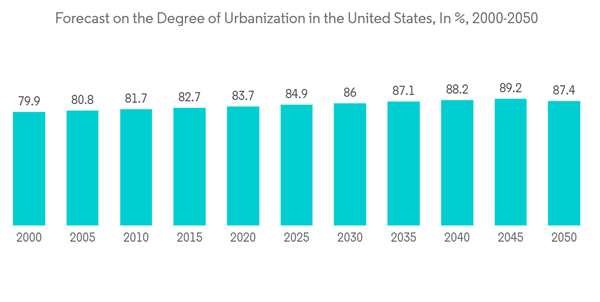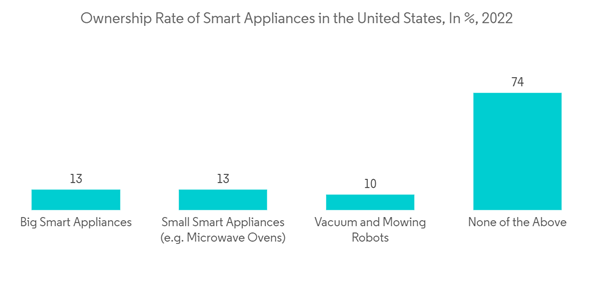The US Microwave Oven Market is valued at about USD 9.4 Billion in the current year, and it is expected to witness a CAGR of more than 4% during the forecast period.
The growth of the microwave oven market in the United States can be attributed to the following factors: the shift in smart lifestyle from home interiors to smart home appliances, the rapid adoption of microwave ovens, the rapid growth of nuclear families in the United States, and the increasing demand of microwave ovens in the United States. Customers want modular kitchens with stylish designs, color options, texture, and cutting-edge features like smart microwave ovens driven by technology in market touch solutions, which helps in forecasting the growth of smart microwave ovens.
Furthermore, due to the constant changes in consumer eating habits and lifestyles, the growth of hotels, restaurants, and cafes is expected to increase the demand for smart kitchen products. As the trend has shifted from traditional to modular kitchens over the years, both residential and commercial customers are eager to invest in smart kitchen products. As the number of nuclear families continues to grow in the United States, as well as the number of women working to increase the income of their families, there is a growing need for microwaves. In the United States, the consumption of ready-to-eat meals is very common, with 96% of households having a microwave oven.
The growing inclination of customers toward spending on appliances to manage kitchen chores drives the growth of the household microwave oven segment. The growing number of smart homes in the United States, mainly in metropolitan cities of the United States such as New York, Chicago, etc., have triggered consumer interest in connectivity-enabled smart appliances. Consumers are opting for smart appliances, like smart microwave ovens, which can be connected to their smartphones and monitored remotely. Moreover, the improvement in network infrastructure across the United States has resulted in better broadband and internet penetration, and consumers from this country prefer wireless and technologically advanced products due to the convenience offered by such products. With the growing trend of home automation in the United States, smart microwave ovens will witness increased adoption over the forecast period.
The coronavirus pandemic has shown an impact on the proper functioning of various industries in various regions. This was primarily due to reduced sales because of the lockdown being imposed and, thus, a halt in logistics and electronic manufacturing. Closures of restaurants caused a ripple effect among related industries such as food production and equipment manufacturers.
In addition, microwavable foods take less time to cook and can be cooked in a regular microwave oven. The demand for convenience foods has been on the rise in recent years due to the growing number of people living in urban areas. In addition, the number of nuclear families is on the rise, and the standard of living is on the rise. With more and more fast-food restaurants popping up in developing countries, it is no surprise that there's a lot of money to be made. In recent years, there has been a surge in demand for delicious food, and that has led to a surge in the sales of pre-packaged food products. Microwavable food manufacturers are providing delicious meals to consumers with little to no prep and cooking time. Today's consumers are constantly looking for healthier food options that are simple to prepare and delicious. Freezing helps keep nutrients in food products that are essential for the production of many vitamins and minerals in your body.
Kitchen appliances such as refrigerators, cooktops, coffee machines, microwaves, and wall ovens can be connected via Wi-Fi or Bluetooth connectivity and can be controlled via smartphones. The modern generation, especially millennials, are moving towards such kitchen appliances because of their hectic lifestyles and work schedules, as well as the ease of use and fast cooking ability of these appliances. Vendors like Robert Bosch, Samsung Electronics, etc., are constantly emphasizing providing fast, intelligent, easy-to-use, and convenient appliances. All these factors are expected to contribute to the market growth during the forecast period.
This product will be delivered within 2 business days.
The growth of the microwave oven market in the United States can be attributed to the following factors: the shift in smart lifestyle from home interiors to smart home appliances, the rapid adoption of microwave ovens, the rapid growth of nuclear families in the United States, and the increasing demand of microwave ovens in the United States. Customers want modular kitchens with stylish designs, color options, texture, and cutting-edge features like smart microwave ovens driven by technology in market touch solutions, which helps in forecasting the growth of smart microwave ovens.
Furthermore, due to the constant changes in consumer eating habits and lifestyles, the growth of hotels, restaurants, and cafes is expected to increase the demand for smart kitchen products. As the trend has shifted from traditional to modular kitchens over the years, both residential and commercial customers are eager to invest in smart kitchen products. As the number of nuclear families continues to grow in the United States, as well as the number of women working to increase the income of their families, there is a growing need for microwaves. In the United States, the consumption of ready-to-eat meals is very common, with 96% of households having a microwave oven.
The growing inclination of customers toward spending on appliances to manage kitchen chores drives the growth of the household microwave oven segment. The growing number of smart homes in the United States, mainly in metropolitan cities of the United States such as New York, Chicago, etc., have triggered consumer interest in connectivity-enabled smart appliances. Consumers are opting for smart appliances, like smart microwave ovens, which can be connected to their smartphones and monitored remotely. Moreover, the improvement in network infrastructure across the United States has resulted in better broadband and internet penetration, and consumers from this country prefer wireless and technologically advanced products due to the convenience offered by such products. With the growing trend of home automation in the United States, smart microwave ovens will witness increased adoption over the forecast period.
The coronavirus pandemic has shown an impact on the proper functioning of various industries in various regions. This was primarily due to reduced sales because of the lockdown being imposed and, thus, a halt in logistics and electronic manufacturing. Closures of restaurants caused a ripple effect among related industries such as food production and equipment manufacturers.
US Microwave Oven Market Trends
Increase in Urbanization Demands for Microwable Foods
As the number of women working increases, so does the need for ready-to-eat foods. Due to their hectic schedules, the demand for quick and easy meals is on the rise. The rapid growth of large-scale retail chains worldwide will also create lucrative opportunities for market participants. Several market participants are investing heavily in research and development (R&D) activities for developing freezing technology.In addition, microwavable foods take less time to cook and can be cooked in a regular microwave oven. The demand for convenience foods has been on the rise in recent years due to the growing number of people living in urban areas. In addition, the number of nuclear families is on the rise, and the standard of living is on the rise. With more and more fast-food restaurants popping up in developing countries, it is no surprise that there's a lot of money to be made. In recent years, there has been a surge in demand for delicious food, and that has led to a surge in the sales of pre-packaged food products. Microwavable food manufacturers are providing delicious meals to consumers with little to no prep and cooking time. Today's consumers are constantly looking for healthier food options that are simple to prepare and delicious. Freezing helps keep nutrients in food products that are essential for the production of many vitamins and minerals in your body.
Smart Kitchen Appliances is Driving the Growth of the Market
The convenience and ease of use of smart kitchen appliances is one of the main reasons for the growth of the market. Today's smart kitchen appliances are simple and convenient to operate. They can be operated from anywhere with a single click on a smartphone using a mobile app that includes various recipes, user guides, shopping support, and controls. The featured mobile app connected to the smart kitchen appliances keeps the user informed about their appliances' activity status. Another important reason behind the growth of the demand for smart kitchen appliances is remote access. It allows the user to perform various tasks at the same time and also saves energy.Kitchen appliances such as refrigerators, cooktops, coffee machines, microwaves, and wall ovens can be connected via Wi-Fi or Bluetooth connectivity and can be controlled via smartphones. The modern generation, especially millennials, are moving towards such kitchen appliances because of their hectic lifestyles and work schedules, as well as the ease of use and fast cooking ability of these appliances. Vendors like Robert Bosch, Samsung Electronics, etc., are constantly emphasizing providing fast, intelligent, easy-to-use, and convenient appliances. All these factors are expected to contribute to the market growth during the forecast period.
US Microwave Oven Industry Overview
The US Microwave Oven Market is very competitive and highly fragmented across the country, offering a huge number of competitive players dominating the market, nowadays grabbing the market more powerfully by mergers and acquisitions and introducing innovations with highly efficient features along with AI. This market is highly competitive due to the presence of both international and local players operating across the country, such as Whirlpool, Bosch Global, Electrolux, Samsung, and many more. Competition in the market is expected to intensify with the vendors coming up with innovative products to meet the changing consumer demands and to increase their customer base. The market will also witness the entry of several new players, resulting in price wars and increased M&As during the forecast period. Moreover, the growing focus on premium microwave ovens will play a key role in the growth of the market in the coming years.Additional Benefits:
- The market estimate (ME) sheet in Excel format
- 3 months of analyst support
This product will be delivered within 2 business days.
Table of Contents
1 INTRODUCTION
4 MARKET INSIGHTS AND DYNAMICS
5 MARKET SEGMENTATION
6 COMPETITIVE LANDSCAPE
Companies Mentioned (Partial List)
A selection of companies mentioned in this report includes, but is not limited to:
- Bosch Global
- IFB
- Panasonic India
- Electrolux
- General Electronics Corporation
- LG
- Samsung
- Whirlpool
- Haier
- Hitachi
Methodology

LOADING...










